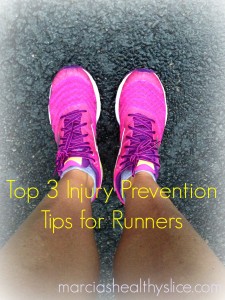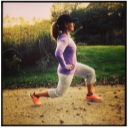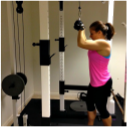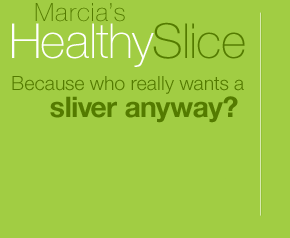Kids please welcome Igor to the blog! He’s a personal trainer talking about something near and dear to my heart: injury prevention. Enjoy!

You’re a passionate, devoted runner. You love running, and it feels good. But when you’re talking to other runners, they always seem to be recovering from some injury. Whether it’s shin splits or hamstring strains, lower back pain or Achilles tendon issues. And you don’t want to be one of “those” runners.
In my practice as both a personal trainer and a speaker (I speak to groups of runners), I use 3 very potent strategies to help runners prevent injuries. Without further ado, here they are:
Strength training has so many benefits for runners beyond injury prevention, that there’s no reason not to do it. Imagine I told you to jump on one leg 2500 times straight. You’d think I was crazy, right? Well, that’s more or less what you are doing when you are running 5K. One mistake runners make is they run to get fit. That’s completely backwards. Given the demands of running, you need to get fit to run.
Strength training effectively prepares your muscles, tendons and ligaments for running. Not only that, but it also raises your ability to tolerate impact. Of course, you are a runner, so you don’t need to train like a bodybuilder. You should really only use 3-5 major exercises, twice per week, with weights that you can do for 5-8 repetitions.
I talk in greater detail about both the injury preventing and performance enhancing aspects of strength training in an article I wrote, titled “Endurance Training: The Missing Element”.
Fortunately, these days when I see a runner for the first time and ask what they are doing for injury prevention, many of them say “foam rolling.” That’s fantastic, because for very little time and money, you are doing a world of good for injury prevention.
A foam roller is a long dense, cylindrical piece of foam (as the name implies). It’s kind of like a self-massager. Although foam rolling doesn’t feel good while you’re doing it (like deep tissue massage), your knees, hips and lower back will really thank you.
Foam rolling helps you break up scar tissue in various areas of your lower body, so it keeps your muscles, tendons and ligaments nice and supple.If you’re rolling your IT band (the side of your thigh), take at least 30 seconds to work your way from your hip to your knee. Yeah, it should be that slow.
Lastly, there is corrective training. What is it? Corrective exercises are very specific stretches and strengthening drills that wake up sleeping muscles, and relax overly tense muscles.
Unlike strength training exercises, these are more “awareness” exercises. It doesn’t feel like you’re working hard, and in the traditional sense of the word, you aren’t. You won’t feel a muscle burn or heavy exertion, but you do need to concentrate on getting the right muscles to activate. Here is a very common example: in a lot of runners (especially female runners), they have weak gluteus medius. That’s one of the muscles of the butt. That causes the knee to slightly cave inwards each time you take a step. Over one step, it’s no big deal, but keep it up over several weeks, months or years, and you’re looking at an MCL tear. Not fun. Especially considering it could have been prevented in a few weeks with a couple simple exercises.
Everyone is different, so different people present with different imbalances. As such, there’s really no one-size-fits-all corrective program. Rather, it should be based on a thorough assessment with a qualified professional to determine which exercises are most appropriate for your body.
Igor Klibanov was selected as one of the top 5 personal trainers in Toronto by the Metro News newspaper. He is the author of “Unlimited Progress: How You Can Unlock Your Body’s Potential.” He is a self described information junkie, and loves to study and educate himself on all aspects of fitness and nutrition.




Great info and tips! Sharing now
Great information. Thank you.
GREAT POST!! Runners need to read! 🙂
All great tips!
You’re so right about getting fit to run. It’s SO important that you don’t hurt yourself because as soon as you do, you stop running. Then it takes forever to get the excitement back in to you and get back out there when you’re healthy. Thanks for sharing!
Nice information! I’ve been injured and it isn’t fun, so I definitely do a lot of preventative stuff now.
Great post and great tips – plus a reminder that I really need to do more foam rolling!!!
Great post!!
However, you did not mention a tip that has been working for me for the last year — don’t run and you will not get injured. You may bruise your ego though. haha
Most of us runners don’t learn to do these until we’ve had an injury or two. I’m still not an enthusiastic participant when it comes to strength but I’ve learnt that if I want to keep running till I’m old (and I do) it’s not going to happen without doing all the stuff that I don’t love but I know is good for me.
Good tips, I keep meaning to get a foam roller.
Wow! Great article. I have pain that shoots down my left hip that I tend to ignore. I’m now thinking I should bo to the sports doc and talk to him about some exercises go help. Maybe it is somethkng easily fixed.
Great tips! I’ve gotten out of the habit of foam rolling- need to get back to it!
Great tips, very interesting post but …. what a pity, I am late because I am already injured!
My youngest son runs all the time. That great insight you have about the rigors of running demanding that you get fit to run … hits it right on the nail’s head! I’m having my son read your 3 step injury prevention technique. I’m sure he’ll love that. thanks for sharing.